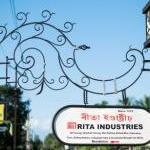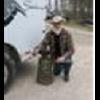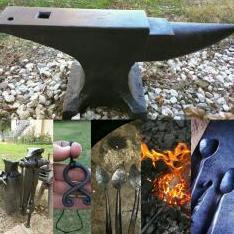
Geoff Keyes
Members-
Posts
265 -
Joined
-
Last visited
Contact Methods
-
Website URL
http://www.5elementsforge.com
Profile Information
-
Gender
Male
-
Location
Duvall Wa
-
Interests
Lots, most involving heavy iron and rust
Recent Profile Visitors
3,480 profile views
-
On Ebay link removed Weird shape, huge price What is it? Geoff
-
What's the oldest tool you have that you still use?
Geoff Keyes replied to Glenn's topic in Everything Else
I've got a 30# Fisher with an 1886 date on it, it's my bench anvil. I've got a pretty big (8") post vice that's all wrought, but it's got no marks on it. All of my machine tools. mill, surface grinder, and lathe are all '30's. Geoff -
Ian, the NWBA is a great resource and I suggest you join. If knife making is what you are interested in, I also teach the craft of the forged blade in my shop in Duvall. Pm me and we can chat. Geoff
-
I'd call it a vice or a clamp, but you've got his contact info in the vid, why not ask him directly? Geoff
-
Making a Fisher anvil, O1 tool steel source?
Geoff Keyes replied to njanvilman's topic in Anvils, Swage Blocks, and Mandrels
Aldo Bruno, the New Jersey Steel Baron has what you need. G -
VFD to control powerhammer?
Geoff Keyes replied to Geoff Keyes's topic in Power Hammers, Treadle Hammers, Olivers
I've got 30 hp of 3 ph converter, so I could go that route. I would like to try this, but right now I found a nice beefy 220 v unit an d I will go with that. Thanks for the replies. I'll check the NWBA thread as well. Geoff -
The motor on my hammer packed it up and while I'm searching for a replacement (the original came from a dead compressor with who knows how many miles on it, 15 years ago), I thought back to a conversation I had with Grant Sarver just before he died. Could you use a VFD as the speed control for a powerhammer? I'm thinking that you could run the belt from the motor to the drive pulley directly, with no clutch. The VFD would be controlled with a foot pedal. The more you depressed the pedal, the faster the motor would run, like a big sewing machine. Could that be made to work? It sounds to me that you'd have both speed control (from O to OMG) and maybe a single blow stroke. The hammer is a shop built mechanical, like a Champion, with a DuPont toggle arm setup, about 50#. Thanks Geoff
-
How Loud is your Anvil?
Geoff Keyes replied to SReynolds's topic in Anvils, Swage Blocks, and Mandrels
I do take issue with the statement about anvils ringing. My best anvil (in terms of rebound) is a 125 # Hay Budden. Since it's on a light stand (because it's my traveler) it rings like a bell. Well bedded, in lead or silicone, it's louder than I would like, but much quieter. I can't say that it is less good to work on in that state. My next best anvil (rebound wise) is a 200# Fisher. It's bolted to 200# of gluelam block. It hardly makes any noise, and is a joy to work on. My everyday anvil is the worst in rebound, but fills my needs better. It's a 6x5x28 post. It's not hardened, hence the poorer rebound, and makes hardly any noise. The movie sound is some Foley guy beating the, uh, stuffing out of some poor ringy anvil, like a Peter Wright, with nothing on the anvil face. You're just going to have to find some other way to advertise when the forge is running. Geoff -
Knapping hammers
Geoff Keyes replied to Frank Turley's topic in Axes, Hatchets, Hawks, Choppers, etc
There also were small tools that a shooter kept in his kit. I have seen ones that were single piece with a screwdriver on one end (for tightening the lock and other bits) a vent pick on the other, folded in the middle to make the hammer face (the pick and driver blade are at right angles), often these are brass, or brass faced (to avoid sparks). Geoff -
New Guy With a New (to me) Anvil Help with ID
Geoff Keyes replied to Oldsarge's topic in Anvils, Swage Blocks, and Mandrels
If you would like to see a shop built hammer like you're describing, I have one. I'm in Duvall, east of Seattle, and I can always handle a shop visit. Geoff -
I recently had an opportunity to work in L6, a steel I've not used before. I ran across a thread from another forum which suggested that L6 could be treated as an air hardening steel. I wanted to test this before getting in too deep. I took some cutoff from the project and following this http://www.bladeforums.com/forums/showthread.php/655904-All-about-L6, used the procedure in the PDF below. I had 4 coupons of the steel (Aldos L6, 0.225 not ground to remove the decarb) 1 I left as delivered 1 air quenched with no temper 1 air quenched, tempered @ 400 for 2, 4 hour sessions 1 oil quenched, tempered @ 400 for 2, 4 hour sessions Detrich at Podforge allowed me to use his Rockwell tester and we got the following results #1 tested 18 Rc +/- 1.5 #2 tested 65 Rc +/- 1.5 #3 tested 55 Rc +/- 1.5 #4 tested 54 Rc +/- 1.5 There is a very nice PDF for L6 here http://www.burgessknives.com/media/L6.pdf, and this is the procedure I used. I can't talk about the project, yet, except to say it's a hard duty blade and in the informal tests I've done so far, it's beating my expectations by a lot. Hope this is useful to folks, Geoff
-
http://video.pbs.org/video/2365021516/ This is really cool. Now if Roy would just shut up Geoff
-
The deciding factor for me was the cost of 3ph equipment. I now have 3 machines that came to me wired for 3ph. By having a converter (I bought 30 hp of rotary converter) I was able to save the cost and labor of converting the machines to 1ph. Lots of old iron goes for cheap because it's 3ph, and people don't want to bother with it. One other thing, 3ph motors are often cheap, because people can't run them. Just my .02 Geoff
-
I hear you got a bit of a rumbler today. Everything OK on your end? Geoff
-
Forging your own anvil
Geoff Keyes replied to theLumberSmith's topic in Anvils, Swage Blocks, and Mandrels
This would be a seriously difficult undertaking. How big an anvil are you thinking? What kind of equipment do you have? A hand forged anvil of any size, say 50lbs and up would require a team of smiths swinging big hammers, not to mention the problems with heating and moving 50lbs of steel at heat. What would you forge it on? A bigger anvil would require a big hammer or a huge press. How would you heat treat your product, once you overcame all of the other issues? Some of the best anvils are cast steel, there is nothing magical about a forged anvil. A good process could get you a good one, but a bad process will just net you junk for all of your effort. Geoff


